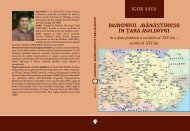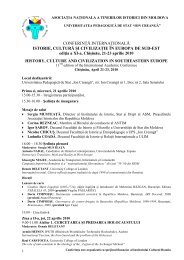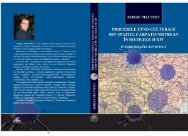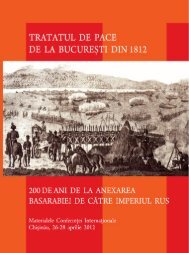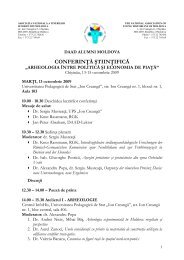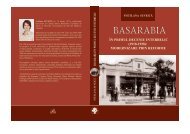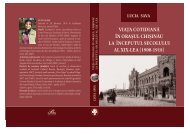- Page 1 and 2:
analele asocıaŢıeı naŢıonale
- Page 3 and 4:
cuprıns epoca antică Corneliu Bel
- Page 5 and 6:
Epoca antică - -
- Page 7 and 8:
diman, 2003c, 2003d, 2004b, 2004d).
- Page 9 and 10:
effectifs et typologie Plus de la m
- Page 11 and 12:
technologiques et culturelle durant
- Page 13 and 14:
CÂRCIUMARU M., MĂRGĂRIT M. et al
- Page 15 and 16:
Fig. 2. Art mobilier au Paléolithi
- Page 17 and 18:
ıdentıtate socıală Şı podoaBe
- Page 19 and 20:
IIIb-IIIc, etapa de locuire A. Pies
- Page 21 and 22:
Cronica cercetărilor arheologice d
- Page 23 and 24:
Fig. . Valve de Unio sp. aparţinâ
- Page 25 and 26:
Dunării a trecut prin teritoriul d
- Page 27 and 28:
ea a fost catalogată ca un mare ca
- Page 29 and 30:
cunoaşte dacă exista şi un recip
- Page 31 and 32:
înşiruire ne poate oferi o idee
- Page 33 and 34:
BıBlıoGraFıe cataloaGe Price 199
- Page 35 and 36:
Poenaru Bordea 2001 - Gh. Poenaru B
- Page 37 and 38:
consıderaŢıı prıvınd Încadra
- Page 39 and 40:
proporţia acestora. În total au f
- Page 41 and 42:
ZusammenFassunG ÜBerleGunGen Zur K
- Page 43 and 44:
Fig. 4. Vârfuri de lance din epoca
- Page 45 and 46:
Plecând de la aceste observaţii,
- Page 47 and 48:
venind din flota de la Misena, ce s
- Page 49 and 50:
După reprimarea marilor răscoale
- Page 51 and 52:
Claudia, la Durostorum (Silistra),
- Page 53 and 54:
Archaeology dell’Universitá di S
- Page 55 and 56:
draGomır, ı. t. 1 . Descoperiri a
- Page 57 and 58:
a. b. Fig. 1. Bărboşi. Promontori
- Page 59 and 60:
arHeoloGıe Şı polıtıcă: caZul
- Page 61 and 62:
şi au construit un stil maiestuos,
- Page 63 and 64:
cultura drıdu Şı evoluŢıa poZ
- Page 65 and 66:
istorice ale unor realităţi arheo
- Page 67 and 68:
lui Adrian Păunescu la începutul
- Page 69 and 70:
omâni în timpul regimului comunis
- Page 71 and 72:
Ages: Issues and Readings, Oxford,
- Page 73 and 74:
neapărat să explice vizitatorilor
- Page 75 and 76:
determınărı & dımensıunı ale
- Page 77 and 78:
utilizează fonduri de stat - au î
- Page 79 and 80:
teorıa celor două popoare - stud
- Page 81 and 82:
„din secolul al Vi-lea până la
- Page 83 and 84:
leme neclarificate. La acestea adă
- Page 85 and 86:
elaŢııle domnılor moldoveı cu
- Page 87 and 88:
în perioada pribegiilor sale la ac
- Page 89 and 90:
ınFluenŢa unıverstăŢıı dın
- Page 91 and 92:
Košice, cum ar fi, spre exemplu, u
- Page 93 and 94:
extindere, cîţiva studenţi de la
- Page 95 and 96:
Majoritatea studenţilor de la Koš
- Page 97 and 98:
estul Germaniei. În 1599 Bocacius
- Page 99 and 100:
tät, Land und Konfession 1500 bis
- Page 101 and 102:
Fig. 1: Universităţile germane ex
- Page 103 and 104:
de la Oliva, ci a încheiat separat
- Page 105 and 106:
Grecıı În comerŢul cu ımperıu
- Page 107 and 108:
proveneau din dările pe vite 1 şi
- Page 109 and 110:
iStORia ROmÂnilOR 2003, vol. V, Ed
- Page 111 and 112:
îi permitea să-şi formeze o opin
- Page 113 and 114:
Cât priveşte St. Leszczynski, dat
- Page 115 and 116:
vizată doi sultani au fost înlăt
- Page 117 and 118:
suedezul în schiţa lui Nicolae Mu
- Page 119 and 120:
alta. Acest proces şi războaiele
- Page 121 and 122:
În aceste condiţii, singura solu
- Page 123 and 124:
Militantul pentru idealurile naţio
- Page 125 and 126:
Bibliografie BODEA, D., 2000. Cuvâ
- Page 127 and 128:
evoluŢıa ımaGoloGıcă a revolu
- Page 129 and 130:
fost creat prin discursul politic,
- Page 131 and 132:
Poporul a fost perceput ca un compl
- Page 133 and 134:
orchestrate de soldaţii secui. Act
- Page 135 and 136:
capabil de a sensibiliza o populaţ
- Page 137 and 138:
olul noBılımıı În vıaŢa puBl
- Page 139 and 140:
ton de Verrayon se propune; a scoat
- Page 141 and 142:
ezumé L’article ,,Le rôle de la
- Page 143 and 144:
olul Şı locul mınorıtăŢılor
- Page 145 and 146:
aspecte ale proGramuluı Şı actı
- Page 147 and 148:
Manifestul din 17 octombrie 1905 a
- Page 149 and 150:
- fracţiunea „Trudovicilor”, c
- Page 151 and 152:
Cоnform informaţiilor secrete, or
- Page 153 and 154:
elaborate de către Comitetul unit
- Page 155 and 156:
locale, solicitând începerea miş
- Page 157 and 158:
„proBlema aromÂnă” Şı cauZe
- Page 159 and 160:
Amplificarea tensiunii diplomatice
- Page 161 and 162:
statul român nu avea cu cine să d
- Page 163 and 164:
Atena s-au complicat pe fundalul co
- Page 165 and 166:
generale sanitare; fiecare inspecto
- Page 167 and 168:
„Monitorul oficial”, Nr. 154 di
- Page 169 and 170:
jud. Soroca. În 1883 este admis la
- Page 171 and 172:
necessıtY oF HumanıZatıon oF tea
- Page 173 and 174:
Subject to «pro et contra», there
- Page 175 and 176:
In Ukraine it is limited by the sys
- Page 177 and 178:
- organizes certification of pedago
- Page 179 and 180:
ınstıtuŢııle cultural-educatı
- Page 181 and 182:
Soroca 1 - unica instituţie de pro
- Page 183 and 184:
în Basarabia. Deja în cadrul lucr
- Page 185 and 186:
„naţionalismul burghez”, absol
- Page 187 and 188:
ÎnvăŢămÎntul ıstorıc superı
- Page 189 and 190:
Menirea acestor instituţii era de
- Page 191 and 192:
funcţia de decan al Facultăţii d
- Page 193 and 194:
Bibliografie BURLACU, Valentin, 200
- Page 195 and 196:
(ianuarie 1918), înăbuşind cu fo
- Page 197 and 198:
Rusia, rămân sub dominaţia Porţ
- Page 199 and 200:
această situaţie se datorează no
- Page 201 and 202:
trecut complet sub tăcere pentru
- Page 203 and 204:
etrospectıva deZvoltărıı orGan
- Page 205 and 206:
cei care călătoreau pentru a găs
- Page 207 and 208:
latGale as lIeUX De MeMOIRe: re-tH
- Page 209 and 210:
It was mistake of Russian administr
- Page 211 and 212:
unique historical way of Latgale -
- Page 213 and 214:
intellectuals in Latgale were very
- Page 215 and 216:
BREŽGO, B., 1940, Latgalos zemniek
- Page 217 and 218:
ţinut până la mijlocul secolului
- Page 219 and 220:
fierari dintre vătraşi. Documente
- Page 221 and 222:
gubernatorului Basarabiei, Scarlat
- Page 223 and 224:
pămÂnturı natale, ıdeal naŢıo
- Page 225 and 226: vreme ce, la Reghin, nu exista o co
- Page 227 and 228: să intre trupele Antantei şi să
- Page 229 and 230: MAJDÚ, Tibor, NAGY, Zsuza L. 1990.
- Page 231 and 232: c) comentarii ale presei dobrogene
- Page 233 and 234: Un loc aparte au ocupat ştirile ca
- Page 235 and 236: Politica de rezistenţă declanşat
- Page 237 and 238: Bibliografie BERSTEIN, Serge, MILZA
- Page 239 and 240: în continuare arenda drept o form
- Page 241 and 242: Tabelul 2 Distribuirea cotelor-păr
- Page 243 and 244: internaţionale, unei societăţi d
- Page 245 and 246: aporturıle repuBlıcıı moldova c
- Page 247 and 248: nimeni nu are dreptul, nu va fi în
- Page 249 and 250: preşedintele Snegur drept „un su
- Page 251 and 252: o prăbuşire a pieţei ruse în 19
- Page 253 and 254: aBStRaCt On September 22, 1990, in
- Page 255 and 256: O alta prioritate în activitatea a
- Page 257 and 258: „cu alte republici ce şi-au proc
- Page 259 and 260: ımplıcaŢıı Geopolıtıce ale u
- Page 261 and 262: în localităţile locuite preponde
- Page 263 and 264: natală. De fapt, aceasta s-a făcu
- Page 265 and 266: polıtıca statuluı FaŢă de ınt
- Page 267 and 268: Politica statului sovietic faţă d
- Page 269 and 270: 5. АRTOBOLEVSKII I., VLADISLAVLEV
- Page 271 and 272: Recenzii - 1 -
- Page 273 and 274: În rezultatul analizei pieselor de
- Page 275: ografia de la sfârşitul lucrării



